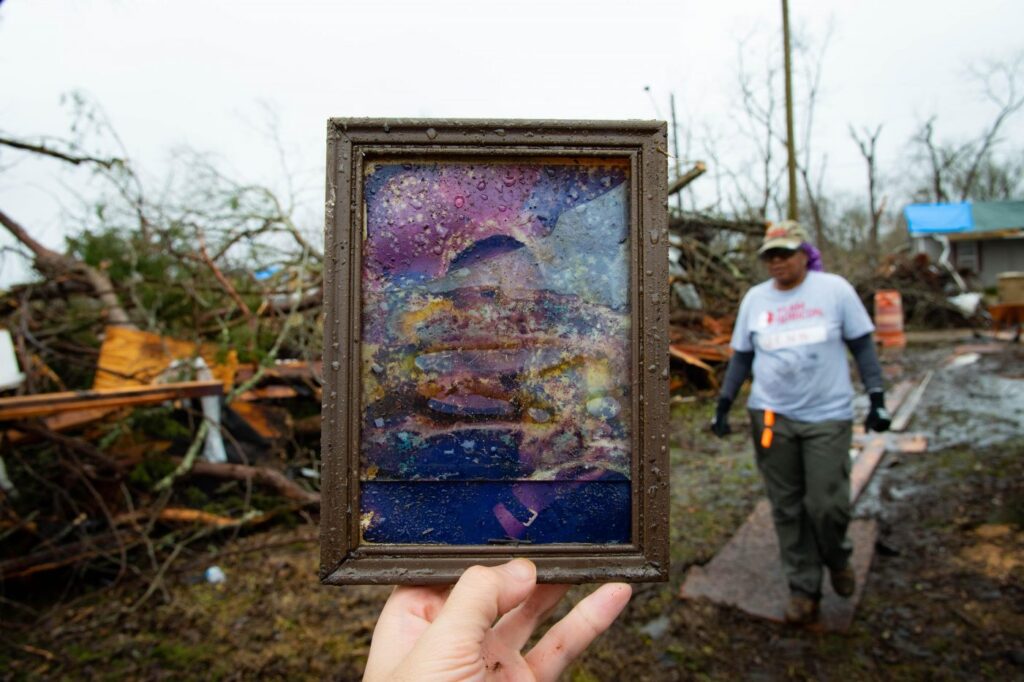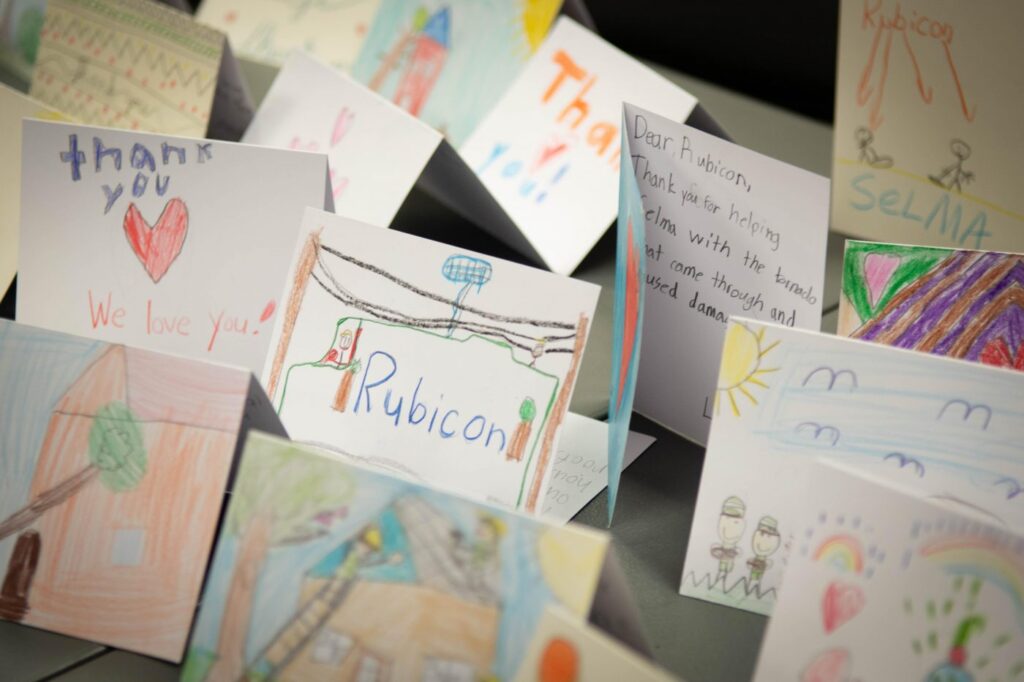On January 12 of this year, a category F3 tornado touched down in Selma, AL, and western Georgia, bringing wind speeds of 158 to 206 miles an hour and causing widespread damage and devastation, including seven deaths in Autauga County, AL. You’d be forgiven if you hadn’t heard about this because few people outside Selma and Alabama have.
Once a bustling naval manufacturing town during the Civil War, Selma is now the sixth poorest city in America, with an estimated 35% of its citizens living below the poverty level. It has lost 20% of its population since 2010 and the exodus continues to this day, exacerbated by COVID-19, two fierce tornadoes, and Hurricane Zeta—four disasters that have deeply tested residents in the space of just 27 months.
Team Rubicon had twice sent volunteers, or Greyshirts, to Selma in response to the March 2021 tornadoes and had even launched a multi-year rebuild program in the Queen City. Yet much remained to be done in the city’s recovery process. Then came this January’s tornadoes, which left yet another swath of devastation in their wake. So, when the disaster relief nonprofit sent out the call to serve the city again, I leapt at the opportunity to serve. I could think of no better, more constructive way to honor and experience Black History Month.

Selma is best known as the birthplace of the voting rights movement in the United States, the scene of the historic and pivotal “Bloody Sunday” tragedy, a man-made disaster that took place in March 1965 on the south side of the Edmund Pettus Bridge. Memorialized in the movie, “Selma” and (most) history books, Bloody Sunday was marked by Alabama police viciously clubbing John Lewis, Hosea Williams, and countless other peaceful demonstrators, shocking the nation and spurring the drafting and passage of the Voting Rights Act. Hundreds of Americans fought and bled—and three perished—in Selma so that all Americans could enjoy the right to self-determination and agency through voting.
As an avid student of Civil Rights Movement history and a Team Rubicon employee and Greyshirt, I was immediately moved to volunteer for this operation. I was curious about what had changed since 1965 and eager to
help Selma recover. I’m grateful to work in an organization that encourages us to participate in supporting and rebuilding marginalized communities impacted by disasters. I wanted to be a part of giving Selma the respect, attention, and support the community needs and deserves after yet another natural disaster—especially a disaster of which most of the country has neither seen nor heard.
I arrived in Selma ready to work, but I also stole some time to explore the city, visit some of the March sites, and to try to better understand the place that has so shaped this country. Standing outside the Brown Chapel AME church, where the Bloody Sunday marchers gathered, I read a plaque explaining that in the 10 years after the Voting Rights Act, the number of Black voters increased from 1.463 million to 3.845 million and Black elected officials increased from 72 to 2,568 in the states affected. I thought about how that is reflected in the fact that Selma currently has a Black mayor. But I also wondered what daily life is like for Selma’s current residents now. Had those sacrifices been fully honored? And, how is it possible that, to this day, the Edmund Pettus Bridge is STILL named after a former Grand Dragon of the Alabama Ku Klux Klan?
Selma is very much the kind of place that gives you the motivation to dig deeper, to serve them better. Maybe it’s just the people; maybe it’s the history of Selma and the city’s importance to the country, or maybe it’s because they can’t seem to catch a break, but there’s something about Selma that makes you want to serve and to give it your max effort when you do. Whatever it was, I was glad to be there.
Team Rubicon’s Selma tornado response operation—named Operation 54 Miles, a nod to the length of the Selma to Montgomery march—had entered its third week by the time I arrived. So, to a certain extent, I imagined much of the city’s cleanup would have been done already. Yet viewing images and watching news footage of tornadoes had done nothing to prepare me for the violent nature of the destruction I would witness in person. Nor did reading about Selma’s poverty statistics prepare me for the staggering volume of abandoned homes and storefronts I’d see there. That I would be part of Team Rubicon’s commitment to Selma, low-attention disasters, and socially vulnerable communities became especially inspiring and motivating.
Driving through town my first afternoon, I saw houses with their roofs torn off, streets dotted with cars flipped on their backs, and enormous trees that had been uprooted and thrust through homes. Dozens of homes had been leveled, stripped clean down to the foundation. Block after block was lined with tree trunks, furniture, appliances, and floorboards in towering stacks.

All this nearly a month after the storm had hit. A full 28 days after the storm and nothing had been removed from the curbs. Team Rubicon was the only relief organization with any meaningful presence in the city, and yet it seemed even we were barely making a dent. To add insult to that injury, every piece of tornado debris we had cleared still lay piled on those curbsides. No one had come to take away the waste and debris.
Why had nothing been picked up? Where was FEMA? Where were the city’s waste haulers? With all of the wreckage still on view, the sense of loss was palpable, visceral. Standing there, taking it all in, I couldn’t imagine how wrenching it must be to see all your belongings piled on a curb, out there for all the world to see, and rotting further in the weather, a full month after the tornado. How disheartening. How horrible.
So, it would be natural to imagine that the mood of the residents living still surrounded by all that tornado debris would be dour, depressed, and maybe even defeated. Natural and incorrect. Everywhere we went, in every home we entered, we were met with resilience; determination. The attitude of those Selmarians fueled our work and commitment to help the city get back on its feet. It became even more impossible to quit working, no matter how exhausted we were, upon seeing the “Thank you for Loving Selma” cards that schoolchildren drew and posted on the wall of the local YMCA that housed us for the week.
It’s impossible to linger on sadness and shock when the local churches are cooking you hot, delicious meals every day and stuffing you with homemade banana cream pudding. It’s impossible to feel anything but grateful for our own jobs when local scrap metal collectors who were “just looking to make an honest dollar” ask if they can take the cast-iron tub that was destined for the curb and landfill.
And, it’s impossible to feel despair at the enormity of the task when you are supported by 45 other Greyshirts, from all walks of life, all giving their time and skills and sweat to help Selma residents recover from arguably one of the worst days of their lives.
My assignment on this operation was with a muck-out team. As the name suggests, we were charged with cleaning out the debris from homes damaged by the storm. Our assigned home had been directly hit, the tornado ripping off the roof, the carport, and part of the brick walls. The homeowner had hastily affixed a series of tarps to the roof, but rain had leaked in, soaking the insulation and damaging the majority of the household items. Black mold had started to appear. The entire home would need to be gutted down to the
studs—hazmat suits and sledgehammers required.
When we met the homeowner—I’ll call him Trey—he was understandably shellshocked, overwhelmed. His demeanor was reserved and somber. He was polite and very grateful to see us but still clearly reeling from the enormity of the damage.

A curious and inspiring thing happened, however, as we made progress stripping the house to its bare bones: The further our benevolent destruction progressed, the brighter Trey’s demeanor became. He began to smile, laugh at jokes, and open up about his family.
He was a hairstylist and even gave one of our crew a haircut. He told us about losing three family members in two years and how his grandfather, the home’s original owner, was a World War II Army veteran. On our fifth and final day of the muck out, another Greyshirt, also an Army veteran, discovered an American flag lying crumpled on the floor. He dusted it off, folded it properly, and presented it to Trey. As it turned out, the flag was his grandfather’s. The presence of only 48 stars signaled its advanced age.
Surveying the final remains of his childhood home, Trey reminisced that he was seven years old when the house was built. He recalled seeing it then as he did now, a skeletal framework of wooden beams and concrete floors. Now that we were done it was bare bones again, and seeing the home returned to its original state gave Trey a feeling he described as “melancholy.”
The home had been swept and prepped to our “TR clean” standards and was ready again for drywall and new flooring. We posed for pictures. Trey hugged each of us, gave us homemade brownies, and we bid him an emotional goodbye. He spoke hopefully but warily about pending FEMA aid he’d been “granted.” We left feeling good about the work we’d done to ready Trey for rebuilding.
But as we left, a nagging doubt crept in: had we shown Trey and Selma the support, respect, and dignity that this special place deserved? Had we given them a little more reason to be hopeful and treated them with dignity? And not least of all, fully prepared Trey’s home for rebuilding, a fresh start?
As our CEO, Art delaCruz, remarked to the 46 Greyshirts and volunteer leaders at the end of our time in Selma, “Heart, sweat, conviction, leadership, and love is all that might be left on those floors.”
A new wave of Greyshirts arrived as I was leaving, and for that I was grateful. There are, I know, dozens more like Trey waiting. And the work in Selma must go on.




